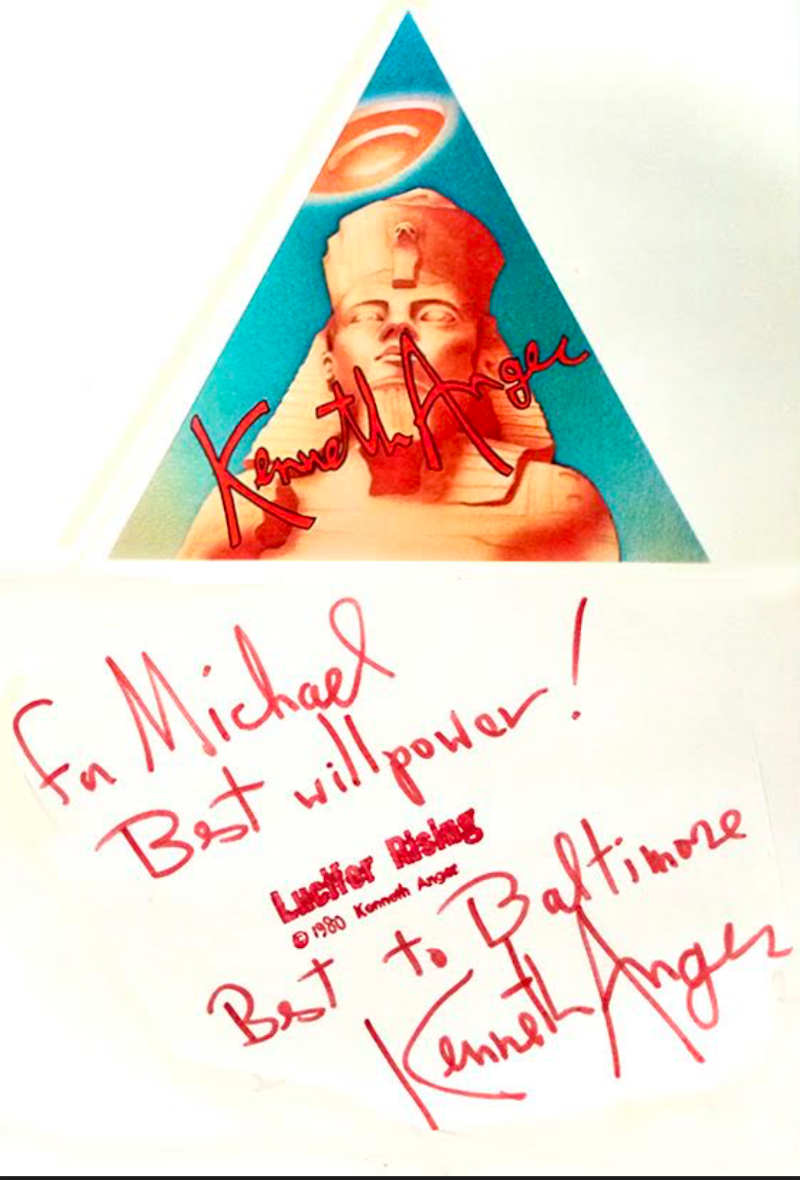In long shadows of Joshua trees surrounding a Mojave Desert hospice on May 11th, Kenneth Anger passed away; he was 96. When Anger spoke or wrote about movies and his upbringing in old Hollywood, the well-spoken, sophisticated, eclectic filmmaker showed excitement. The pioneer queer cinema maestro conducted his entire life’s work outside the mainstream, producing an ensemble of over 30 short films. He frequently made in-person appearances at film screenings where a set of know-all eyes sparkled with glints of devilishness.
Given that Anger was a lifelong pagan and sun worshipper, it seems likely this wasn’t his first death. A life as a devil in disguise further implies that he may have made a long-term pact with Satan. The hellraiser wore the word “LUCIFER” tattooed in capital letters across his chest. His mystical ability to invoke the spirits, turned his films into metaphysical poems and fantasies, marked by an unmistakable style that played a significant role in the development of American avant-garde.
Prior to the advent of digital technology, Anger meticulously maneuvered his forbidden subject matter at ease working with traditional cameras. He helped mark a pop culture starting point that resulted in music videos. His fragmentary storytelling style was frequently used without proper acknowledgment, which made it an easy target to cherry-pick over the decades. A respectful gesture of thanks can be seen in Irma Vep; clips appeared in the 2022 television series.
As a child, Anger acted in 1934’s A Midsummer Night’s Dream and danced with Shirley Temple. You want subversive: amazing to think at the age of 20 in 1947, he orchestrated a full-frontal countercultural assault playing the lead in the personal homoerotic Fireworks. Considered subversive for the 1940s, the film is a cornucopia of taboos, including sadomasochism that resulted in obscenity charges which he won.
The surrealist 1954 Inauguration of the Pleasure Dome captures a colorful occult ceremony portraying gods and demons in a bizarre mind blast. There are appearances by writer Anaïs Nin as a goddess in a bird cage hat with cameos by Satanist Anton LaVey and occultist Aleister Crowley. In 1964, Elvis, James Dean and Marlon Brando idolatry appears in Scorpio Rising; inflamed leather fetish desires smolder when biker boys ready their motorcycles. Marianne Faithfull, flying saucers and member of the Manson Family, Bobby Beausoleil, help mold an Egyptian world of Lovecraftian madness in 1972’s Lucifer Rising.
Also in his repertoire, the groundbreaking 1959 book: Hollywood Babylon where he described Tinseltown’s glitz and glam scandals, highlighting the tarnished underbelly of the movie business.
Naturally, this fascination with Anger’s work began in an art school classroom. In order to watch Lucifer Rising in person back then, it was necessary to cross county lines and make the drive from Baltimore to Washington, DC. During a 1980 in-person appearance, he shared a quirky anecdote about his obsessional tendencies toward a cherished reel of 16mm Kodachrome film he shot in Hollywood in the old days. In order to keep the color from fading, he kept the film refrigerated, gradually lowering the temperature one degree daily until it reached an ideal temperature in order to prevent condensation before projecting.
As my legs nervously swayed back and forth, Anger shredded our sensibilities, showing an unhinged view of the world condemned by the Church, my guilty Catholic eyes widened. I could’ve listened to those stories for hours; he made extravagant behavior seem commonplace and stirred the psyche. Though I’ve never been one for autographs, spotting him in the lobby after the event with a stack of postcards, just couldn’t help myself. He signed in red ink, of course.
Moving on; a sad state of affairs was discovered May 20th in a cockroach-ridden Paris apartment. Photographer Ari Boulogne was found in advanced state of decomposition. Boulogne’s entire life was an attempt gain recognition from of an estranged “alleged” father who ignored him, French actor Alain Delon. His well-known mother Nico was an actress and the Velvet Underground singer who fell off her bike and died in 1988 on the island of Ibiza at the age of 49.
After her death, Boulogne experienced a nervous breakdown. Boulogne accompanied mom on her notorious drug-fueled, shared syringe, worldwide music tours. He appears in early Warhol films and goes on to pursue a drug-dependent lifestyle involved with photography.
It was just another day in 1967, when an inquisitive child crept across the floors of Max’s Kansas City and the Hotel Chelsea. A Getty image shows Nico, Mary Woronov, and Andy Warhol holding Ari outside the Rivoli Theatre for a movie premiere that year. Ari’s looking directly into the camera, revealing a child’s wondering gaze. Nico wrote her only son a lullaby; “Ari’s Song” fulfilled its dark prophecy “Sail away, sail away my little boy. Let the wind fill your heart with light and joy.”
Boulogne made it to 60, in a wheelchair and poor health. His caregiver companion who found the body is in police custody. There’s an ongoing investigation into failure to help someone in need and the disposal of illegal narcotics. Perhaps this subtle remembrance, with its irrevocable vestiges of the past, paints a picture of a drug addict fighting back tears, longing through a child’s nomadic eyes, wondering about the past and what comes next.

